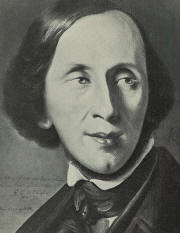
, I maintain that the shoemakers' guild is the most famous, for I am the son of a shoemaker '
Hans Christian Andersen
painted in Dresden
by August Grahl 1846
Nothing but the show-dish -entirely insipidIn some posthumously printed aphorisms Andersen writes: "There is no other true nobility than that of the mind, and in times to come princes will choose their great men from it. In Denmark nobility means Tordenskjold, Bartholin, Griffenfeld, Tycho Brahe, Ørsted, Thorvaldsen. ..Most of those of noble birth are no more than the shield-bearers of the nobility of the mind; they are nothing but the show-dish, entirely insipid."
After Andersen's death one of his literary executors found among his papers a draft entitled "Which guild is the most famous?" from which the following is an extract: I maintain that the Shoemakers' Guild is the most famous, for I am the son of a shoemaker. By all means, let the other guilds, the carpenters', the blacksmiths', the tailors', the braziers', the watchmakers' -indeed, all the many indispensable artisans skilful at their respective trades, send their spokesmen, prove their fame to be greater than that of the shoemakers. Phidias and Ahasuerus, Hans Sachs, the shoemaker! ...An eagle is part of royal coats-of-arms,. the shoemakers have such a one too, even with two heads, and nobody has ever made any complaint about it. In London, that great metropolis, they have begun publishing a Shoemakers' Journal in our time. No aristocratic family has been written so much about as the Wandering Jew, a shoemaker. He lives in legends and songs and is immortal. From Nuremberg, at the time of the Mastersingers, the name of Hans Sachs, the shoemaker, shines forth. Our age has given each trade its own right, each man is free to speak his mind; the word nobility applies to anything that is clever, whether coming from behind the plough, from the workshop, or from science and art. It has been said, it has been written. But now let us confine ourselves to the workshop, that of the shoemaker. I who write these lines was born down there. Andersen was well aware of the irony that he, who really despised "the nobility of the blood" and believed in "the nobility of the mind", should be so pleased to spend so much time with the Danish aristocratic families in their beautiful manors and castles. His dilemma was the dilemma of the goblin in his own story "The Goblin at the Grocer's", who came to realize that his heart lay with the poor student in the attic and that this was where he really belonged. But then he had second thoughts about moving up there: "I can't give up the grocer altogether, because of the cream and the butter ," and the story ends philosophically: "That was quite like a human being. We, too, have to go to the grocer for the cream and the butter."
Andersen went to his aristocratic friends "for the cream and the butter", but his heart was not with them. And yet he had lost contact with the social class from which he came and a sudden confrontation with social outcasts was liable to frighten him. He wrote in his diary on June 26, 1850: " A nasty vagabond stood near the spring, I had a feeling tha the might know who I was and might tell me something unpleasant, as if I were a pariah moved up into a higher caste." |